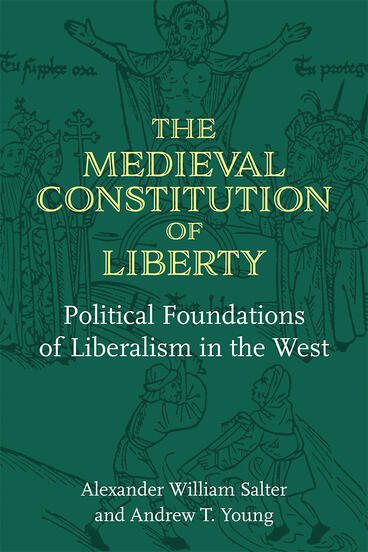The Medieval Constitution of Liberty
Political Foundations of Liberalism in the West
Locating the roots of western liberal democracy in the late medieval period rather than the Age of Enlightenment
Description
Why did enduring traditions of economic and political liberty emerge in Western Europe and not elsewhere? Representative democracy, constitutionalism, and the rule of law are crucial for establishing a just and prosperous society, which we usually treat as the fruits of the Renaissance and Enlightenment, as Western European societies put the Dark Ages behind them.
In The Medieval Constitution of Liberty, Salter and Young point instead to the constitutional order that characterized the High Middle Ages. They provide a historical account of how this constitutional order evolved following the fall of the Western Roman Empire. This account runs from the settlements of militarized Germanic elites within the imperial frontiers, to the host of successor kingdoms in the sixth and seventh centuries, and through the short-lived Carolingian empire of the late eighth and ninth centuries and the so-called “feudal anarchy” that followed its demise. Given this unique historical backdrop, Salter and Young consider the resulting structures of political property rights. They argue that the historical reality approximated a constitutional ideal type, which they term polycentric sovereignty. Salter and Young provide a theoretical analysis of polycentric sovereignty, arguing that bargains between political property rights holders within that sort of constitutional order will lead to improvements in governance.
Alexander William Salter is Georgie G. Snyder Associate Professor of Economics in the Rawls College of Business at Texas Tech University.
Andrew T. Young is Professor of Economics in the Rawls College of Business at Texas Tech University.
Reviews
“In this fascinating new contribution, Salter and Young provide us with a rich account of the development of a certain style of politics in Medieval Europe, one based on fundamental liberties, and they suggest how this was eventually linked to Europe’s economic rise. A welcome new addition covering a very particular historical trajectory.”
- David Stasavage
—David Stasavage, New York University
“Salter and Young are to be commended on producing such an accessible and insightful book.”
- Mark Koyama
—Mark Koyama, George Mason University
“The Medieval Constitution of Liberty is a superb book. It begins with a short tour through the Maddison data. From 1 AD to 1600, income per capita was virtually flat. But starting in the late 18th century forward, the west grew by a factor between 30 and 45. Known variously as the ‘European Miracle,’ the Great Enrichment, or the hockey stick of economic growth, the ‘disparity between the West and the rest is the salient social fact of modernity.’ Salter and Young argue that the West’s political and economic liberty which began in the early Middle Ages, but especially the High Middle Ages, helps explain this fundamental fact of modernity. Liberty, in turn, requires a ‘polycentric’ approach to governance, that is, multiple sources of power, constitutions, and other political institutions. Medieval assemblies, for example, that in some Western European countries much later would become a source of representative institutions, often began as creatures of the monarch for purposes of addressing collective action problems, credible commitment problems, and coordination problems."
- Barry R. Weingast
—Barry R. Weingast, Stanford University
“The Medieval Constitution of Liberty is ambitious and thought-provoking. It tackles, with erudition, one of the enduring puzzles of modern history—the origins of Western constitutions and norms of liberty. It also wisely rejects both theories that put the strength of the state and elites as the driving force and also those that see a special role for European culture. I recommend this fascinating book strongly.”
- Daron Acemoglu
—Daron Acemoglu, co-author of Power and Progress: Our Thousand-Year Struggle over Technology and Prosperity
"Salter and Young trace the unique connection between good governance and wealth creation in the West leading up to the High Middle Ages. Although modern equality before the law necessitated the weakening of intermediate institutions, the contemporary lesson points to the value of pluralism in the maintenance of political and economic liberty."
- CHOICE
--CHOICE

